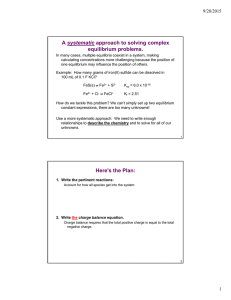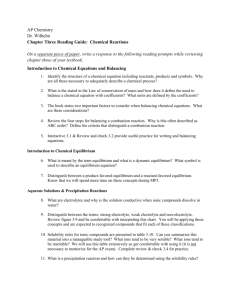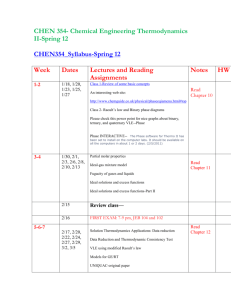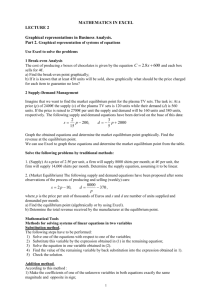SCH 4U Learning Goals
advertisement
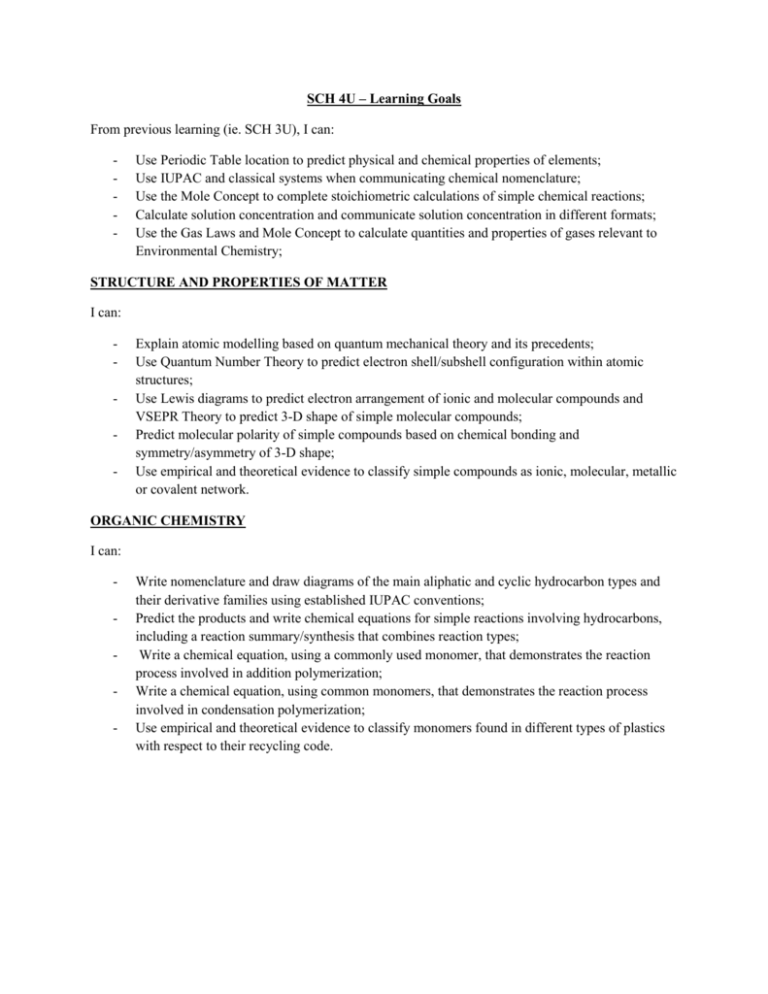
SCH 4U – Learning Goals From previous learning (ie. SCH 3U), I can: - Use Periodic Table location to predict physical and chemical properties of elements; Use IUPAC and classical systems when communicating chemical nomenclature; Use the Mole Concept to complete stoichiometric calculations of simple chemical reactions; Calculate solution concentration and communicate solution concentration in different formats; Use the Gas Laws and Mole Concept to calculate quantities and properties of gases relevant to Environmental Chemistry; STRUCTURE AND PROPERTIES OF MATTER I can: - Explain atomic modelling based on quantum mechanical theory and its precedents; Use Quantum Number Theory to predict electron shell/subshell configuration within atomic structures; Use Lewis diagrams to predict electron arrangement of ionic and molecular compounds and VSEPR Theory to predict 3-D shape of simple molecular compounds; Predict molecular polarity of simple compounds based on chemical bonding and symmetry/asymmetry of 3-D shape; Use empirical and theoretical evidence to classify simple compounds as ionic, molecular, metallic or covalent network. ORGANIC CHEMISTRY I can: - Write nomenclature and draw diagrams of the main aliphatic and cyclic hydrocarbon types and their derivative families using established IUPAC conventions; Predict the products and write chemical equations for simple reactions involving hydrocarbons, including a reaction summary/synthesis that combines reaction types; Write a chemical equation, using a commonly used monomer, that demonstrates the reaction process involved in addition polymerization; Write a chemical equation, using common monomers, that demonstrates the reaction process involved in condensation polymerization; Use empirical and theoretical evidence to classify monomers found in different types of plastics with respect to their recycling code. ENERGY CHANGES AND RATES OF REACTION I can: - - Determine the enthalpy of a physical or chemical process using either mathematical equations, the mole concept or potential energy diagrams, or combinations thereof; Use empirical and theoretical evidence to evaluate the process and procedure involved in determining the molar enthalpy of combustion for simple alcohols; Use Hess’ Law of Additive Enthalpies, tables showing enthalpies of formation for common compounds or multistep problems to algebraically calculate the enthalpy for a chemical system; Use the mole concept to calculate reaction kinetics for different species in a simple chemical system; Calculate the reaction order of a different species in a chemical system, the overall order of reaction, and the rate constant, given data with respect to initial concentration and reaction kinetics; Use graphical analysis of empirically-derived data to predict the reaction order of a specific species in a chemical system. CHEMICAL SYSTEMS AND EQUILIBRIUM I can: - - Explain the qualitative characteristics of a chemical system in dynamic equilibrium using both chemical equations and graphical format, and write chemical equations to differentiate between solution equilibria, phase equilibria and reaction equilibria; Use balanced chemical equations to determine an Equilibrium equation which can be used for Quantitative Analysis; Use Le Chetalier’s Principle and equilibrium equations to predict the equilibrium shift for a chemical system undergoing variations in environmental conditions; Use ICE Tables and equilibrium equations to determine equilibrium concentrations of different species in a reaction equilibria and a solution equilibria; Use free energy, entropy and temperature data to predict the spontaneity of a reaction equilibria; Use ICE Tables, equilibrium equations and Bronsted-Lowry Theory to determine equilibrium concentrations in acid-base chemical systems. ELECTROCHEMISTRY I can: - Identify oxidizing agents and reducing agents in an oxidation-reduction (REDOX) chemical system; Balance simple redox reactions using the oxidation number method and/or half-reaction method; Use given standardized data to identify the oxidation and reduction half components of a redox system; Calculate the overall potential difference of a redox system based on the potentials of the half reactions.





